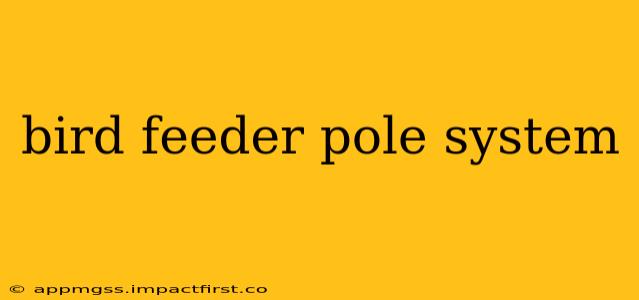Attracting feathered friends to your backyard is a rewarding experience. A sturdy and well-placed bird feeder pole system is key to providing a safe and convenient dining spot for your avian visitors. This guide dives into everything you need to know about choosing and installing the perfect bird feeder pole system, answering frequently asked questions to help you create the ideal bird-watching haven.
What are the Different Types of Bird Feeder Pole Systems?
Bird feeder pole systems vary significantly in design, material, and features. Understanding these differences is crucial for selecting the right system for your needs and garden aesthetic.
- Basic Metal Poles: These are the most affordable option, usually consisting of a simple metal pole driven into the ground. They're lightweight but can be less stable and susceptible to rust.
- Heavy-Duty Metal Poles: Offering increased stability and durability, these poles are thicker and often galvanized or powder-coated for rust resistance. They are ideal for larger feeders and windier locations.
- Wood Poles: Wooden poles provide a more natural look, blending seamlessly into many garden settings. However, they require regular maintenance to prevent rot and insect infestation.
- Multi-Tiered Systems: These systems offer multiple feeding stations on a single pole, maximizing space and catering to different bird species.
- Hanging Pole Systems: These utilize a hanging system rather than a directly ground-planted pole, allowing for easier access for filling and cleaning.
What is the Best Height for a Bird Feeder Pole?
The ideal height for a bird feeder pole depends on several factors, including the type of birds you wish to attract, the surrounding vegetation, and your personal preferences. Generally, placing the feeder 5 to 6 feet off the ground is a good starting point. This height discourages ground predators like cats and raccoons while still providing easy access for many bird species. However, adjusting the height might be necessary based on your specific circumstances.
How Do I Keep Squirrels Away From My Bird Feeder?
Squirrels are notorious for raiding bird feeders. Several strategies can help deter these furry thieves:
- Squirrel-resistant feeders: These feeders utilize baffles, cages, or weight-activated mechanisms to prevent squirrels from accessing the seeds.
- Pole baffles: These are cone-shaped or cylindrical devices placed on the pole below the feeder, creating a physical barrier for squirrels.
- Slick poles: Applying a substance like petroleum jelly or a commercial squirrel repellent to the pole makes it difficult for squirrels to climb.
- Strategic placement: Placing feeders away from trees and other climbing structures can also reduce squirrel access.
What is the Best Material for a Bird Feeder Pole?
The best material for a bird feeder pole depends on your budget, aesthetic preferences, and the climate in your area.
- Metal: Metal poles are durable and long-lasting, particularly when galvanized or powder-coated. They resist rot and insect damage.
- Wood: Wooden poles offer a natural aesthetic but require regular maintenance to prevent rot and damage.
- PVC: PVC poles are also durable, lightweight, and resistant to rot and insect damage.
How Do I Protect My Bird Feeder Pole From Predators?
Predators such as cats and raccoons can pose a significant threat to birds using your feeder. Several measures can improve safety:
- Height: Placing the feeder at a sufficient height discourages ground predators.
- Baffles: Placing baffles on the pole prevents climbing predators from reaching the feeder.
- Protective cages: Some feeders come with protective cages that shield the birds from predators.
- Careful placement: Avoid placing feeders near trees or other structures that predators could use to access them.
How Do I Install a Bird Feeder Pole?
Installing a bird feeder pole is relatively straightforward:
- Choose a location: Select a location away from trees and other structures that predators could use to access the feeder.
- Prepare the ground: Dig a hole deep enough to firmly secure the pole.
- Set the pole: Place the pole in the hole and fill it with concrete or firmly pack the soil around it.
- Attach the feeder: Once the concrete is set, attach your chosen bird feeder to the pole.
By carefully considering the factors outlined in this guide, you can select and install a bird feeder pole system that will attract a variety of birds and provide them with a safe and reliable food source for years to come. Remember to prioritize safety, stability, and aesthetics to create a truly enjoyable bird-watching experience.
